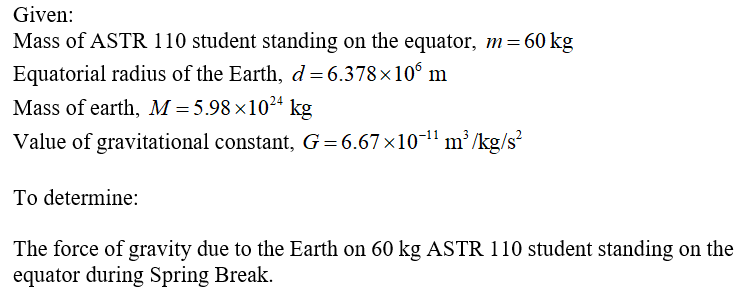We all know the Earth exerts gravity on us, but other objects in the solar system also pull on us. In the following series of problems we will investigate how strong gravity is for a person standing on the surface of the Earth from various objects in the solar system. You can answer the following series of questions using Newton's Law of Gravity; use the units given and the Gravitational Constant, G = 6.67 ×10 -11 m 3 /kg/s 2 . 9.What is the force of gravity due to the Earth on a 60.0 kg ASTR 110 student standing on the equator during Spring Break. DATA: Equatorial radius of the Earth 6.378 ×106 meters ; mass of the Earth 5.98×1024 kgusing the right formula: Fg = (G M1 M2 / d^2)
We all know the Earth exerts gravity on us, but other objects in the solar system also pull on us. In the following series of problems we will investigate how strong gravity is for a person standing on the surface of the Earth from various objects in the solar system. You can answer the following series of questions using Newton's Law of Gravity; use the units given and the Gravitational Constant, G = 6.67 ×10 -11 m 3 /kg/s 2 . 9.What is the force of gravity due to the Earth on a 60.0 kg ASTR 110 student standing on the equator during Spring Break. DATA: Equatorial radius of the Earth 6.378 ×106 meters ; mass of the Earth 5.98×1024 kgusing the right formula: Fg = (G M1 M2 / d^2)
College Physics
11th Edition
ISBN:9781305952300
Author:Raymond A. Serway, Chris Vuille
Publisher:Raymond A. Serway, Chris Vuille
Chapter1: Units, Trigonometry. And Vectors
Section: Chapter Questions
Problem 1CQ: Estimate the order of magnitude of the length, in meters, of each of the following; (a) a mouse, (b)...
Related questions
Topic Video
Question
100%
- We all know the Earth exerts gravity on us, but other objects in the solar system also pull on us. In the following series of problems we will investigate how strong gravity is for a person standing on the surface of the Earth from various objects in the solar system. You can answer the following series of questions using Newton's Law of Gravity; use the units given and the Gravitational Constant,
- G = 6.67 ×10
-11
- m
3
- /kg/s
2
- .
- 9.What is the force of gravity due to the Earth on a 60.0 kg ASTR 110 student standing on the equator during Spring Break. DATA: Equatorial radius of the Earth 6.378
×106 meters
- ; mass of the Earth
5.98×1024 kgusing the right formula: Fg = (G M1 M2 / d^2)
- .
Expert Solution
Step 1

Trending now
This is a popular solution!
Step by step
Solved in 2 steps with 2 images

Knowledge Booster
Learn more about
Need a deep-dive on the concept behind this application? Look no further. Learn more about this topic, physics and related others by exploring similar questions and additional content below.Recommended textbooks for you

College Physics
Physics
ISBN:
9781305952300
Author:
Raymond A. Serway, Chris Vuille
Publisher:
Cengage Learning

University Physics (14th Edition)
Physics
ISBN:
9780133969290
Author:
Hugh D. Young, Roger A. Freedman
Publisher:
PEARSON

Introduction To Quantum Mechanics
Physics
ISBN:
9781107189638
Author:
Griffiths, David J., Schroeter, Darrell F.
Publisher:
Cambridge University Press

College Physics
Physics
ISBN:
9781305952300
Author:
Raymond A. Serway, Chris Vuille
Publisher:
Cengage Learning

University Physics (14th Edition)
Physics
ISBN:
9780133969290
Author:
Hugh D. Young, Roger A. Freedman
Publisher:
PEARSON

Introduction To Quantum Mechanics
Physics
ISBN:
9781107189638
Author:
Griffiths, David J., Schroeter, Darrell F.
Publisher:
Cambridge University Press

Physics for Scientists and Engineers
Physics
ISBN:
9781337553278
Author:
Raymond A. Serway, John W. Jewett
Publisher:
Cengage Learning

Lecture- Tutorials for Introductory Astronomy
Physics
ISBN:
9780321820464
Author:
Edward E. Prather, Tim P. Slater, Jeff P. Adams, Gina Brissenden
Publisher:
Addison-Wesley

College Physics: A Strategic Approach (4th Editio…
Physics
ISBN:
9780134609034
Author:
Randall D. Knight (Professor Emeritus), Brian Jones, Stuart Field
Publisher:
PEARSON